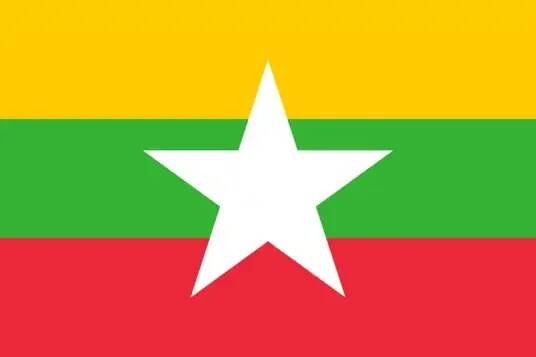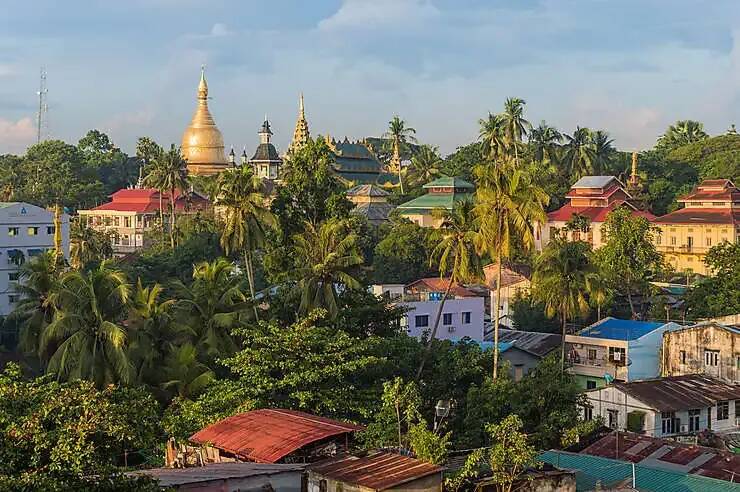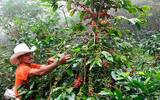Introduction to the development of planted varieties industry in Myanmar coffee producing areas in Asian countries
In Asia, there are many coffee producing countries, such as Laos, Indonesia, East Timor, Thailand, China and Myanmar.
Myanmar (Myanmar)
The Union of Myanmar (The Republic of the Union of Myanmar) is a Southeast Asian country with a land area of 676578 square kilometers, bordering the Sea of Myanmar in the southwest, India and Bangladesh in the northwest, China in the northeast and Thailand and Laos in the southeast.
The Burmese flag is rectangular and consists of yellow, green and red stripes of the same width from top to bottom. In the middle of the flag is a big white five-pointed star, covering the tricolor horizontal band and pointing upward. Among them, yellow represents unity, wisdom, joy and close unity of all nations, while green represents a country with fertile, harmonious, peaceful and green land, red represents bravery and decisiveness, and white five-pointed stars represent purity, integrity, friendliness and strength.

Myanmar is a land and sea country with a coastline of 3200 km, high in the north and low in the south, surrounded by mountains in the north, west and east, high mountains in the north, Naga hills and Rokai mountains in the west, and Shan plateau in the east. Kaikabo Peak, near the Chinese border, is the highest peak in the country at 5881 meters above sea level. Between the western mountains and the eastern plateau is the alluvial plain of the Irrawaddy River, which is low and flat.
Myanmar has a tropical monsoon climate, most of the land is located in the tropics south of the Tropic of Cancer, and a small part of it is located in the subtropics north of the Tropic of Cancer. It is hot and humid in summer, rainy from June to September, and dry and mild from December to April in winter. the topography, hills, valleys and mountains, coupled with hot days and cool nights, have a good ecological environment and few natural disasters. it creates ideal conditions for coffee cultivation.

Coffee producing area
In the late 19th century, British colonists invaded and controlled the country, and in the 1930s, Catholic missionaries brought coffee to Shan State in northern Myanmar and began to grow coffee. The coffee industry really began to develop in the 1980s when the local government, in cooperation with the United Nations, launched a project aimed at replacing illicit opium poppy production with coffee trees (for opium).
Most of the coffee produced in Shan State is grown by small farmers, most of whom grow less than one hectare. About 80 per cent of the coffee grown is Arabica coffee for export, while 20 per cent grows robusta, mostly for self-sale. Common varieties include Caturra Kaddura, Catimor Katim, Bourbon bourbon, Typica tin pickup, S795 and SL34. The harvested fruit will be picked and sorted and sent to the processing station for processing.
The cultivation of Burmese coffee is mainly concentrated in Naoqiu area of Shan State (Shan State) Province, Yeran area, Bowo area and Bin Wulun area of Mandalay Province. Coffee is also being grown in Chin, Bago, Dandangji and Bowo.
Shan State (Shan State): a state in northern Myanmar bordering Xishuangbanna, Yunnan, China. It is also the largest and most populous state in Myanmar. The area is largely surrounded by the Yunnan-Guizhou Plateau and has one of the longest rivers in Asia, the Salween River, and coffee is grown at an altitude of between 800 and 1800 meters.
Mandalay province (Mandalay): located in central Myanmar, the province is a collection of plateau mountains, plains and hilly woodlands for 1.1 provinces, with a diverse climate and fertile soil provided by extinct volcanoes, making it ideal for agricultural cultivation, with coffee grown mostly between 9-2000 meters above sea level.
Present situation of coffee industry
At present, Myanmar is constantly developing the coffee industry, expanding the coffee planting base of 279000 acres (about 170000 mu) in 2024, and there are plans to expand the planting area of coffee in Myanmar to 300000 acres (about 1.82 million mu) in the future. and it will bring a significant increase to the local coffee production five years later.
Important Notice :
前街咖啡 FrontStreet Coffee has moved to new addredd:
FrontStreet Coffee Address: 315,Donghua East Road,GuangZhou
Tel:020 38364473
- Prev

Coffee leaf rust is high! Honduran coffee production will be reduced by 24%
Recently, the U.S. Department of Agriculture released the status of the coffee industry in Honduras, a Central American country. According to the report, Honduras is the largest producer and exporter of washed Arabica coffee in Central America, but recently Honduras has suffered a series of problems that have led to a decrease in production. According to the report, Honduras 2023/2
- Next

Attention! Order scams target coffee shops! You cannot accept "wealth and wealth" at will!
▲ Click to pay attention| Daily Boutique Coffee Culture Magazine Coffee Workshop "Hello, our school has a group building event tomorrow night and we need to order some coffee and desserts. "When they hear that customers need to order food for group building activities, many bosses may suddenly have a 'ding' in their minds and realize that a big order has arrived! recent days
Related
- Being chased out of the rain in front of Starbucks?! Store: Sheltering from rain under umbrellas poses a safety hazard
- The white moonlight has changed?! Lucky launches "Big Winter Pear American"
- Hand-brewed coffee three-stage method, high-sweet and universal brewing method to share! What does the high sweet water level of hand-brewed coffee mean?
- What is the difference between raw, refined and full espresso coffee? How to extract espresso and taste good?
- A complete list of coffee bean names and their meanings! What is Yejia Shefi coffee? Where is Mantelin coffee?
- What grade does Arida Manor Kaduai coffee beans belong to? What treatment is Arida ASD slow anaerobic sun exposure?
- The milk tea cup becomes smaller?! Overlord Tea Girl launches a new "Return to Yunnan" series
- Accused of selling counterfeit and high-priced coffee beans! Well-known boutique coffee brand "Oukelao" bowed and apologized!
- How to make espresso dumplings? Can I eat coffee and glutinous rice balls together?
- Save the unformed and stagnant powder cakes in one second! What is the problem with stagnant water in the powder bowl of the espresso machine?

